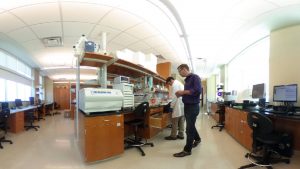Student Spotlight: Wagner Helps Validate Traditional Plant-Based Medicines

Undergraduate research can take students to some interesting places. Recent Plant Biology graduate Charles Wagner (BS ’16) knows that well. Wagner spent most of the summer of 2015 on the Isle of Arran in southwest Scotland as an intern with two master herbalists from the Scottish School of Herbal Medicine. His objective was to learn as much as possible about plants used in traditional Celtic medicine.
“My mother’s side comes from Orkney. This is a connection that has been nurtured throughout my life through traditional music, stories, dialect, and food,” he said. “I chose to study in Scotland because I wanted to learn what my ancestors used for medicine and also to devote research to a subject that has been given little modern scientific attention.”
As an intern, Wagner focused on identifying plants that were documented as early as the 13th century to treat infections. Some of these plants commonly occur in the vast Scottish landscape.
“What surprised me most about my project was simply how many plants were being used by Celtic people. A big ‘aha’ came when I realized that some of the most effective plants are essentially weeds, growing abundantly along roadsides. The somewhat desolate nature of the North European landscape hides many secrets.”

Wagner used a mobile biodiscovery kit to test for antimicrobial activity of extracts from more than 100 species during his internship. Upon returning to the United States last fall, he worked with Dr. Slavko Komarnytsky at the Plants for Human Health Institute in Kannapolis to run further biochemical assays on a subset of the species and identify compounds with antibacterial activity. Wagner said that the lab analysis component has been an integral part of his ethnobotanical research.
“You need to be able to validate your findings from the field to prove to the scientific community that indigenous and traditional knowledge is highly valuable. Laboratory methods show us that people have been right all along and can help integrate the knowledge into the mainstream,” he said.
Wagner recently gave a talk about his work at the international Society for Economic Botany meeting in June. He was one of the only undergraduates to do so. An abstract of his talk appears below.
Wagner plans to continue analyzing plants used in Celtic traditional medicine as part of the research for his master’s degree, which he begins this fall under the direction of Dr. Jillian De Gezelle at NC State.
“Ethnobotany provides the opportunity to travel and learn from other cultures as well as deepen one’s understanding of how they fit into the natural world. It gives you the knowledge to understand more deeply, the essential things in life like food and medicine,” he said. “It is the science of survival.”
-C. Jordan
“Antibacterial Activity of Medicinal Plants from the Physicians of Myddvai, 13th Century Welsh Medical Text”
Authors: Charles Wagner1, Maureen Robertson2, Keith Robertson2, Mickey Wilson1, Slavko Komarnytsky1, and Jillian De Gezelle1 (1NC State University, 2Scottish School of Herbal Medicine)
Reports of traditional Celtic plant medicine date back to Roman times, however a major barrier for successful integration of these remedies into mainstream practice is the current lack of accurate interpretation and scientific validation. Based on a translation of the 13th century Welsh medical text recorded by the Physicians of Myddvai, a list of 165 plants used historically for treating infections likely caused by microbial pathogens was compiled. Fresh plant samples of 107 species from this list (95 genera, 46 families, and 27 taxonomic orders) were collected during a 2 month field trip to the Isle of Arran, Scotland, and analyzed in situ for antimicrobial activity using mobile biodiscovery kits with human saliva as a source of bacteria for screening. From those plants, 67 species (62.6%) were found to have detectable levels of antimicrobial activity. The families Asteraceae, Amaryllidaceae, Apiaceae, Brassicaceae, Lamiaceae, and Rosaceae collectively contributed 42 species with antibacterial properties, highlighting their critical importance to Celtic herbal medicine. In a follow-up proof-of-concept study, bioassay-guided fractionation was performed, yielding antimicrobial constituents from one of the high scoring hits (juniper “berries,” Juniperus communis L.) Quantitative analysis showed both hexane and ethyl acetate fractions to have a strong antibacterial activity against a gram-positive Staphylococcus aureus, while only the hexane fraction effectively inhibited growth of a gram-negative Escherichia coli. Sabinene, a natural bicyclic monoterpene from juniper “berries,” showed the highest antimicrobial activity with MIC values in the range of 58-215μg/ml, thus validating traditional Celtic medicinal plant knowledge and the mobile biodiscovery screening approach. Using historical medical sources such as those associated with traditional Celtic medicine to guide rigorous, evidence-based scientific pharmacognosy therefore provides additional natural sources of new and alternative bioactive molecules for combating bacterial and infectious diseases, as well as inevitable antimicrobial resistance.
This post was originally published in College of Agriculture and Life Sciences News.


